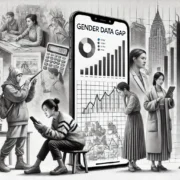Despite the rapid advancement of artificial intelligence (AI) tools like ChatGPT, there is a noticeable gender disparity in their adoption. Studies reveal that women are significantly less likely to use AI tools in their professional lives compared to men, even when they hold similar jobs. This trend raises concerns about the potential long-term impacts on women’s careers and the evolving workforce dynamics.
The Gender Gap in AI Usage
A study published in June by Anders Humlum of the University of Chicago and Emilie Vestergaard of the University of Copenhagen highlights this gap. Surveying 100,000 Danish workers across various professions, the research found that women are consistently less likely to use ChatGPT than their male counterparts. For instance, only a third of female teachers reported using the tool for work, compared to half of male teachers. In the field of software development, nearly two-thirds of men utilised ChatGPT, while less than half of the women did the same. This disparity persisted even when comparing individuals within the same company and job role, with a 16-percentage-point gap still evident.
One of the primary reasons for this gap, the study suggests, may be a lack of confidence among women in using new technologies. Women who did not use AI tools were more likely than men to express a need for additional training. This indicates that self-assurance, or the lack thereof, plays a significant role in whether women feel comfortable integrating AI into their work.
The Role of Perfectionism and Social Expectations
Further insights come from a study by Daniel Carvajal, Catalina Franco, and Siri Isaksson, who examined AI usage among students at the Norwegian School of Economics (NHH). They found that female students, especially those who were mid- to high-performers, were 18 percentage points less likely to use ChatGPT regularly than their male peers. Interestingly, this reluctance seemed to stem from an internalised expectation to do things the “right” way, without taking shortcuts, even when those shortcuts are perfectly acceptable and could enhance productivity.
Siri Isaksson referred to this phenomenon as the “good girl” syndrome, where high-achieving women feel compelled to adhere strictly to traditional methods, avoiding tools they perceive as “cheating.” This mindset may be preventing them from taking full advantage of AI technologies that could streamline their work.
The Potential Long-Term Impact on Careers
This hesitation to embrace AI could have serious implications for women as they enter the job market. The same study extended its research to include a survey of 1,143 hiring managers, revealing that managers value high-performing women with AI expertise 8% more than those without. This premium was not observed for male candidates, indicating that women who acquire AI skills may be more competitive in the job market. However, if women continue to shy away from these tools, they risk falling behind their male peers, particularly in fields where AI proficiency is becoming increasingly important.
Tera Allas from McKinsey raises concerns about the future design and integration of AI tools, warning that if AI continues to be predominantly used by men, it might evolve in ways that are more appealing to them, potentially sidelining women further. However, some experts, like Danielle Li from the Massachusetts Institute of Technology, suggest that the current gender disparity might not necessarily translate into a productivity gap. She argues that at this stage, AI tools like ChatGPT may function more as digital toys rather than essential productivity tools. If that’s the case, high-achieving women might simply be avoiding distractions rather than missing out on critical advancements.
Moving Forward
The findings from these studies underline the need for addressing the gender gap in AI usage. Encouraging women to gain confidence in using AI tools, providing adequate training, and challenging the “good girl” mentality could help bridge this divide. As AI becomes more embedded in the workplace, it is crucial that both men and women feel equally empowered to leverage these technologies, ensuring that no one is left behind in the digital transformation of the workforce.






